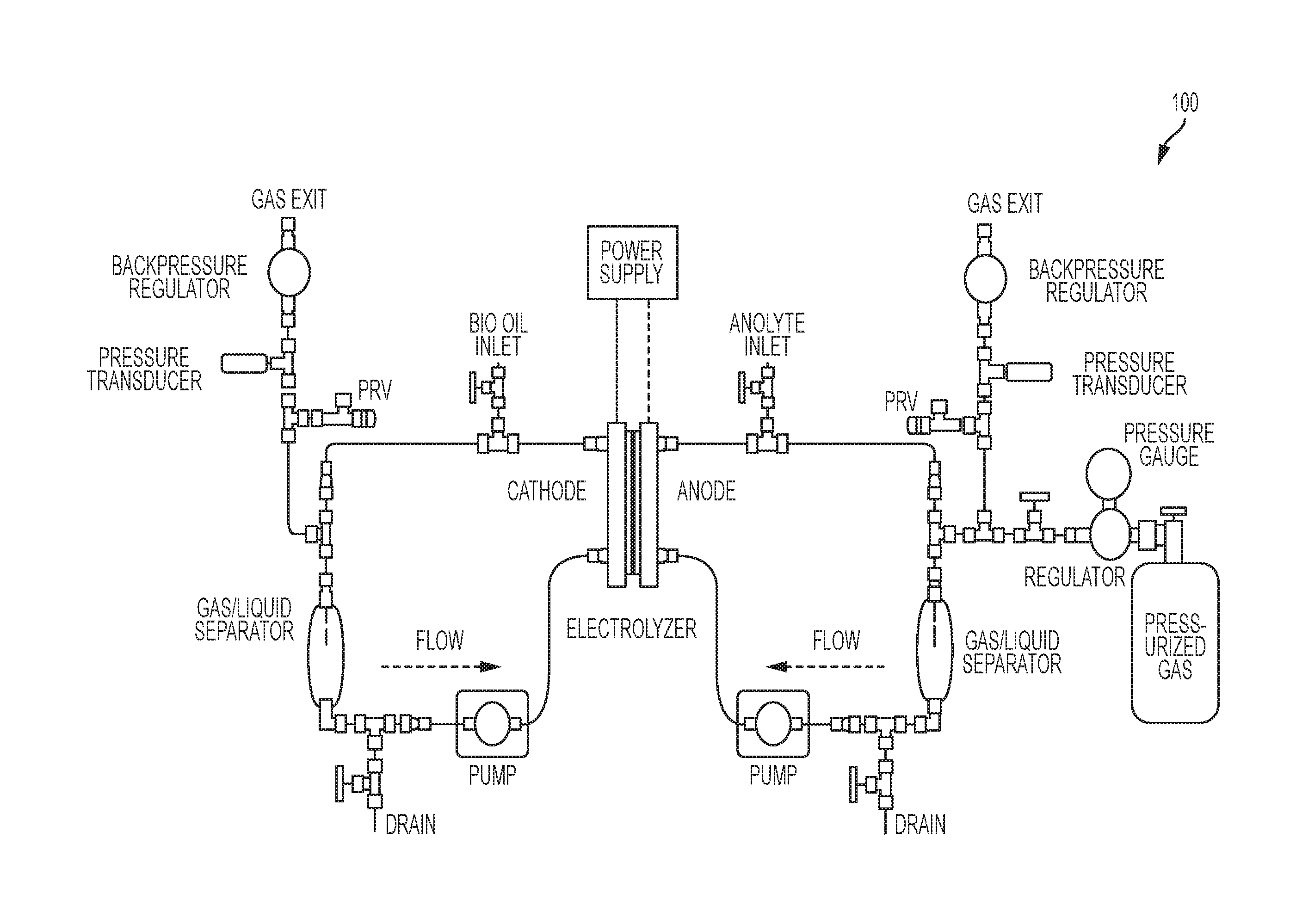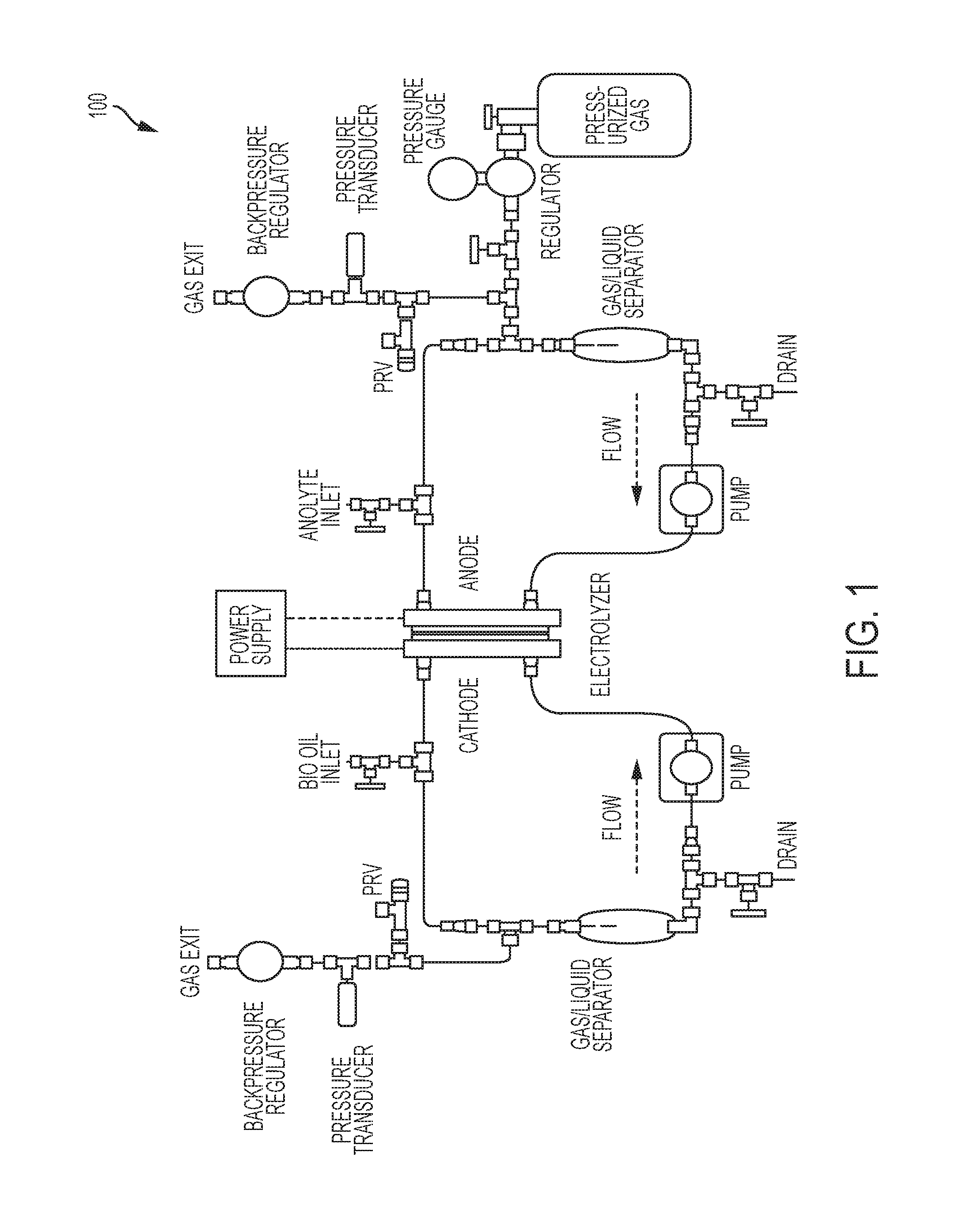System and process for electrochemical upgrading of bio-oils and biocrudes
a biocrude and electrochemical technology, applied in the field of system and process for electrochemical upgrading of biooils and biocrudes, can solve the problems of bio-oil corrosive, bio-oil corrosive, and bio-oil reactive species, so as to reduce reactive functionalities, reduce corrosive, and more stable compounds
- Summary
- Abstract
- Description
- Claims
- Application Information
AI Technical Summary
Benefits of technology
Problems solved by technology
Method used
Image
Examples
example 1
Electrochemical Hydrogenation
[0048]10 mL of bio-oil was added to the cathode chamber. 20 mL of purified water was added to the anode chamber. A direct current (DC) power supply delivered a constant current to the electrolyzer. The pressure increased gradually in the cathode chamber as H2 was generated (i.e., self-pressurized). The anode chamber containing water was maintained approximately 15 psi above the cathode pressure using both self-generated O2 and argon gas supplied from an external argon gas supply. A potential versus time curve during a 6 hour reaction at 0.95 amps (i.e., 0.95 A) shows a very flat profile indicating stable operation observed in all runs. TABLE 1 lists experimental conditions from several experiments performed to test electrochemical hydrogenation of bio-oil. Experimental conditions including the cathode catalyst, current density, time, and temperature were varied. Values for maximum pressure are those recorded at the end of the experiments given that press...
example 2
Separation
[0049]Experiments were performed with a dual membrane cell (see FIG. 3) employing both an AEM and a CEM on surrogate mixtures containing formic acid and acetic acid (5% acetic acid and 3% formic acid) in water as representative systems for pyrolysis oils. The center compartment was filled with a concentrated stream containing 10 mL solution of 1 M Na2SO4. The anode solution was 10 mL of purified water. A constant current of 0.1 A was applied to the cell during operation. Cell voltage was recorded. Experiments were performed for a time between 1 to 4 hours. Solutions were collected after operation and volume and mass were recorded and compared to initial values. pH was also recorded before and after operation. A sample of each solution was analyzed for acetic and formic acid.
[0050]FIGS. 4A-4B plot data obtained from experiments in which surrogate mixtures containing acetic acid and formic acid (i.e., catholytes), concentrates, and anolytes were sampled at regular intervals ...
example 3
[0051]Bio-oil samples electrochemically treated in the single-membrane cell (FIG. 2) were analyzed using several methods including, e.g., NMR, UV-VIS, elemental analysis, Karl Fisher titration, acid titration, and determination of carbonyls by a reaction / titration method. TABLE 2 summarizes the 13C NMR data. Data are shown graphically in FIG. 5 and FIG. 6.
% Carbon, by 13C NMRTotalEther +CarbonylCarboxylPhenolicAromaticAlcoholsEtherAliphaticAlcoholsp2sp3sp2 / Run #(220-200)(185-170)(170-142)(142-95)(95-62)(62-45)(35-0)(95-45)(170-95)(95-0)sp3FP-Feed6.495.6913.7830.3221.664.5517.5126.2144.1043.721.01Run # 25.466.446.7912.3819.3122.1127.5041.4219.1768.920.28Run # 35.547.6110.3512.5617.6516.7029.5934.3522.9163.940.36Run # 46.946.317.7112.4320.1419.9726.5040.1120.1466.610.30Run # 54.054.625.5910.8919.9521.9732.9441.9216.4874.860.22Run # 66.587.624.6314.4726.9617.8721.8744.8319.1066.700.29Run # 73.805.326.5718.7524.1014.0927.3738.1925.3265.560.39Run # 84.064.846.6511.5123.20...
PUM
| Property | Measurement | Unit |
|---|---|---|
| pressures | aaaaa | aaaaa |
| total acid number | aaaaa | aaaaa |
| current | aaaaa | aaaaa |
Abstract
Description
Claims
Application Information
 Login to View More
Login to View More - R&D
- Intellectual Property
- Life Sciences
- Materials
- Tech Scout
- Unparalleled Data Quality
- Higher Quality Content
- 60% Fewer Hallucinations
Browse by: Latest US Patents, China's latest patents, Technical Efficacy Thesaurus, Application Domain, Technology Topic, Popular Technical Reports.
© 2025 PatSnap. All rights reserved.Legal|Privacy policy|Modern Slavery Act Transparency Statement|Sitemap|About US| Contact US: help@patsnap.com



